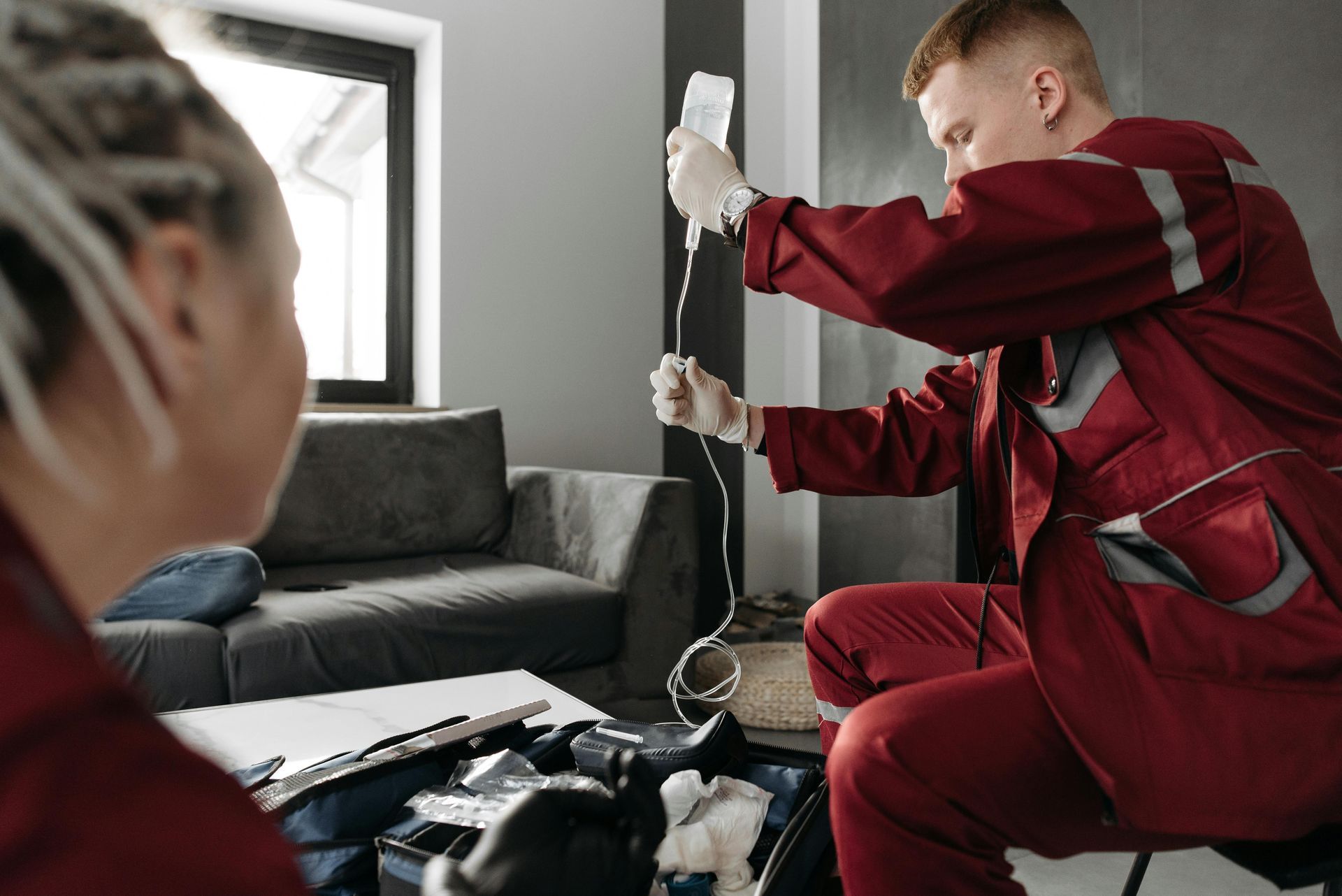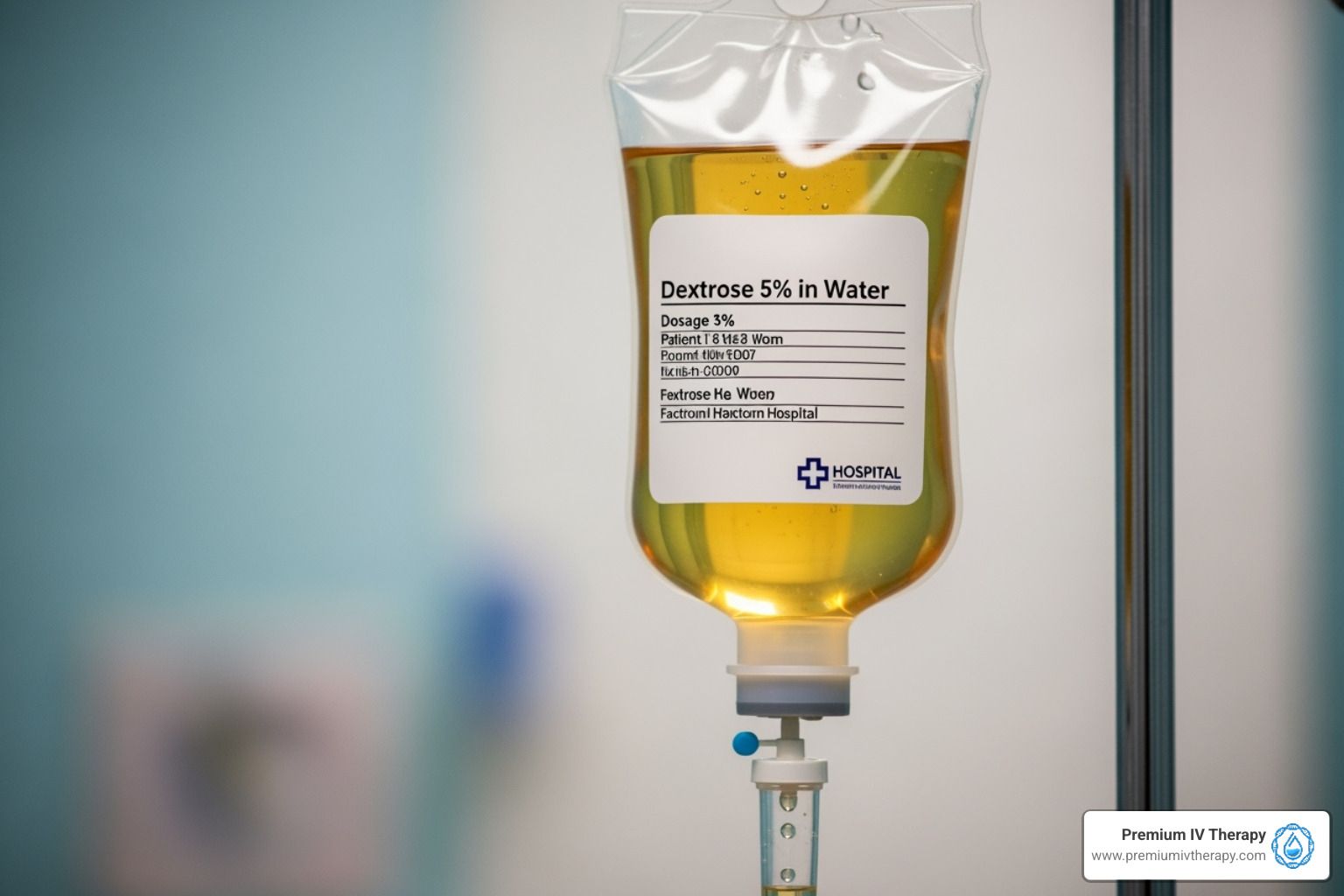IV Therapy for UTI: When to Use IV Antibiotics and Fluids
IV therapy for UTI isn’t a stand-alone “UTI drip.” In practice, a vein is used mainly to deliver IV antibiotics when the infection is severe, when vomiting prevents oral meds, or when kidney involvement/sepsis is a concern; IV fluids are added to correct dehydration or support blood pressure, not to eradicate bacteria. Uncomplicated bladder infections are usually treated with oral antibiotics, with IV care reserved for sicker cases and then stepped down to pills once stable.
At Premium IV Therapy, licensed RNs deliver mobile IV hydration and wellness treatments across the East Valley—or you can visit the Mesa center when that’s easier. Our care is overseen by an experienced medical director and provided by a team of skilled nurses focused on safe, comfortable infusions. If your symptoms point to a UTI that may require IV antibiotics, we help you get prompt medical evaluation and can provide supportive IV hydration as appropriate while you follow your clinician’s treatment plan.
When is IV therapy for UTI actually needed?
Not every UTI needs a drip. This quick guide explains when IV therapy for UTI is medically appropriate based on symptoms, severity, and safety. Scan the list below to see when IV antibiotics (with supportive fluids) are recommended and when oral treatment is enough.
- Suspected kidney infection (pyelonephritis) or “systemically unwell.” High fever, chills, flank pain/CVAT, or toxicity point toward upper-tract infection that often requires IV therapy for UTI (IV antibiotics ± IV fluids).
- Signs of sepsis or hemodynamic instability. Low blood pressure, fast breathing/heart rate, confusion, or rigors warrant urgent IV antibiotics and supportive IV fluids.
- Unable to take oral antibiotics. Persistent vomiting, severe nausea, or inability to keep pills down → start IV therapy for UTI until oral meds are tolerated.
- Pregnancy with suspected pyelonephritis. Pregnant patients with fever/flank pain typically begin parenteral (IV) antibiotics in a monitored setting before stepping down to oral therapy.
- Urinary obstruction or stones with infection. An obstructed, infected system is an emergency—requires rapid source control plus IV antibiotics.
- Immunocompromised or high-risk urinary anatomy. Diabetes, immunosuppressive therapy, transplants, neurogenic bladder, indwelling catheters, or recent urologic procedures increase complication risk and may justify IV therapy for UTI when systemically unwell.
Rule of thumb: Use IV therapy for UTI when the infection is beyond the bladder and the patient is sick enough (sepsis risk, can’t take oral meds, pregnancy with pyelo, obstruction, or significant comorbidity). Start IV, stabilize, get cultures, then step down to oral as soon as it’s safely possible.
Does IV therapy for UTI mean IV antibiotics, IV fluids, or both?
Short answer: usually antibiotics, sometimes both.
- IV antibiotics treat the infection itself. They’re used when the UTI is severe (e.g., kidney infection/pyelonephritis), there’s sepsis risk, or you can’t keep pills down. Once you’re improving and able to take oral meds, clinicians step you down to pills.
- IV fluids don’t kill bacteria. They’re supportive used to correct dehydration and stabilize blood pressure in sicker patients (e.g., vomiting, hypotension, sepsis).
How IV therapy for UTI works in real life (by scenario)
- Uncomplicated bladder infection (cystitis): No IV needed—managed with oral antibiotics. Hydration helps symptoms but doesn’t cure infection.
- Kidney infection (pyelonephritis), stable patient: Often start IV (e.g., a parenteral dose) and review by ~48 hours; step down to effective oral therapy once afebrile and improving.
- Severe pyelonephritis or sepsis: Use broad-spectrum IV antibiotics immediately and give IV fluids to support circulation (initial bolus commonly 30 mL/kg for septic shock/hypoperfusion), then de-escalate when cultures return and the patient stabilizes.
- Pregnancy with pyelonephritis: Inpatient management with parenteral antibiotics and hydration until clinically improving; complete about 14 days total therapy.
When do pregnant women with a UTI need IV therapy?
Most pregnancy UTIs are simple bladder infections (cystitis) that are safely treated with 5–7 days of oral antibiotics—no IV needed. IV therapy for UTI in pregnancy is reserved for sicker cases or when pills aren’t an option.
You’ll likely need IV antibiotics (often with IV fluids) if:
- You have kidney infection (pyelonephritis) or feel “systemically unwell” with high fever, flank/back pain (CVA tenderness), rigors, or signs of toxicity. These cases are usually managed in the hospital with IV antibiotics first, then switched to oral once you’re improving.
- You can’t keep oral meds down due to vomiting or severe nausea. IV treatment is started and stepped down to pills when you can tolerate them.
- There are sepsis concerns (very low blood pressure, fast breathing/heart rate, confusion). Alongside IV antibiotics, clinicians give early IV fluids to stabilize circulation (commonly ~30 mL/kg in shock).
Bottom line: In pregnancy, think IV when the UTI has moved beyond the bladder (fever + flank pain), when you’re too sick to take pills, or when sepsis is a concern. Otherwise, most cases are managed with oral antibiotics and close follow-up.
First-line options in IV therapy for UTI (empiric antibiotics)
When a UTI is serious enough to need an IV, clinicians start with a broad, reliable IV antibiotic, then narrow once culture results come back.
- Most common starting choice: a third-generation cephalosporin (e.g., ceftriaxone). It covers the usual UTI bacteria and is well tolerated.
- If the patient is very sick (sepsis) or at high risk for resistant germs: hospitals may start broader agents (e.g., cefepime, piperacillin-tazobactam, or a carbapenem) until cultures guide a safer, narrower option.
- If there’s a severe allergy or special situation: alternatives are chosen case-by-case (e.g., aminoglycosides in combination, or other classes).
- Important: nitrofurantoin doesn’t reach kidney tissue—it’s not used for kidney infections or complicated UTIs and shouldn’t be the IV step-down in those cases.
Why it works this way: start strong to control the infection quickly, then “de-escalate” to the narrowest effective drug to reduce side effects and resistance.
How Premium IV Therapy supports IV therapy for UTI

At Premium IV Therapy, we help you understand when IV therapy for UTI is truly needed. Our licensed RNs do a quick clinical triage (symptoms, red flags, ability to keep pills down) and guide you to the safest setting. If you’re dehydrated, we can provide IV hydration at home or in our Mesa center to help you feel better while you follow your prescriber’s antibiotics plan. Hydration eases symptoms; antibiotics treat the infection.
How Premium IV Therapy fits into your UTI care
- Nurse-led hydration, mobile or in-center. Book online, get a quick clinician consult, and a registered nurse manages your drip—most visits run ~45–60 minutes. Helpful when dehydration is worsening UTI symptoms or you’re recovering after urgent care.
- Licensed, experienced team. Care is delivered by registered nurses and overseen by a medical director—so your hydration plan is customized to how you’re feeling that day.
- Where we come to you. Mobile IV service across the East Valley—Mesa, Tempe, Gilbert, Chandler, Queen Creek, Apache Junction, San Tan Valley, Gold Canyon—plus options for Phoenix/Scottsdale/Glendale. Concierge service includes a travel fee for small groups (per FAQ).
- Pregnancy-friendly hydration. Pregnancy-friendly hydration. Hydration can ease UTI or morning-sickness discomfort while your OB prescribes pregnancy-safe antibiotics; our “Mommy + Me” blend, as stated in our menu, supports general pregnancy symptoms. Pyelonephritis in pregnancy still begins with monitored IV antibiotics.
When red flags suggest you may need IV antibiotics, we coordinate prompt evaluation at urgent care, an infusion center, or the ER. For stable patients placed on at-home IV antibiotics (OPAT) by their clinician, we work alongside your care team and support your step-down to oral meds. Not sure where you fit? Contact Premium IV Therapy for nurse-led triage and clear next steps. We keep iv therapy for uti safe, appropriate, and aligned with your doctor’s plan.











